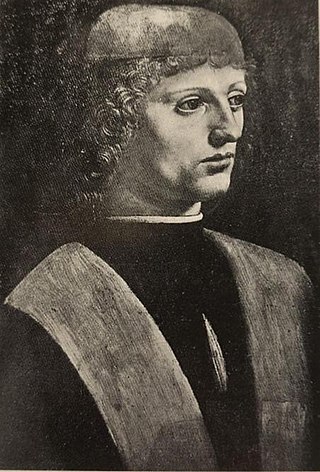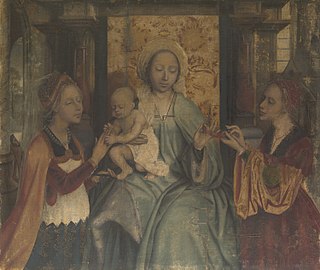In art, an underpainting is an initial layer of paint applied to a ground, which serves as a base for subsequent layers of paint. Underpaintings are often monochromatic and help to define color values for later painting. Underpainting gets its name because it is painting that is intended to be painted over (see overpainting) in a system of working in layers.
There are several different types of underpainting, such as veneda, verdaccio, morellone, imprimatura and grisaille. [1] The different types have different colourings. Grisaille is plain grey. Verdaccio is a grey tending towards yellow or green that brings out more luminous tones, while imprimatura uses earth tones. [2]
Underpainting has several advantages over working from a plain canvas. The neutral colours of the underpaint will not distract if they are not completely covered. It also aids the painter in getting a correct tone. Comparing colours to a white background is very different from the colouring of the final painting. [3] A multi-color underpainting can also add to a work and was used by artists such as Giotto (whose technique is described in detail by Cennino Cennini), as well as by Jan van Eyck and Rogier van der Weyden (whose technique has been studied with modern scientific analysis). This technique was pioneered by Titian in the High Renaissance. The colors of the underpainting can be optically mingled with the subsequent overpainting, without the danger of the colors physically blending and becoming muddy. If underpainting is done properly, it facilitates overpainting. If it seems that one has to fight to obscure the underpainting, it is a sign that it was not done properly.

Oil painting is the process of painting with pigments with a medium of drying oil as the binder. It has been the most common technique for artistic painting on wood panel or canvas for several centuries, spreading from Europe to the rest of the world. The advantages of oil for painting images include "greater flexibility, richer and denser colour, the use of layers, and a wider range from light to dark". But the process is slower, especially when one layer of paint needs to be allowed to dry before another is applied.

Impasto is a technique used in painting, where paint is laid on an area of the surface thickly, usually thick enough that the brush or painting-knife strokes are visible. Paint can also be mixed right on the canvas. When dry, impasto provides texture; the paint appears to be coming out of the canvas.

Scagliola is a type of fine plaster used in architecture and sculpture. The same term identifies the technique for producing columns, sculptures, and other architectural elements that resemble inlays in marble. The scagliola technique came into fashion in 17th-century Tuscany as an effective substitute for costly marble inlays, the pietra dura works created for the Medici family in Florence. The use of scagliola declined in the 20th century.

Grisaille is a painting executed entirely in shades of grey or of another neutral greyish colour. It is particularly used in large decorative schemes in imitation of sculpture. Many grisailles include a slightly wider colour range.

Sgraffito is a technique either of wall decor, produced by applying layers of plaster tinted in contrasting colours to a moistened surface, or in pottery, by applying to an unfired ceramic body two successive layers of contrasting slip or glaze, and then in either case scratching so as to reveal parts of the underlying layer. The Italian past participle sgraffiato is also used, especially of pottery.

Fresco-secco is a wall painting technique where pigments mixed with an organic binder and/or lime are applied onto a dry plaster. The paints used can e.g. be casein paint, tempera, oil paint, silicate mineral paint. If the pigments are mixed with lime water or lime milk and applied to a dry plaster the technique is called lime secco painting. The secco technique contrasts with the fresco technique, where the painting is executed on a layer of wet plaster.

Roughcast or pebbledash is a coarse plaster surface used on outside walls that consists of lime and sometimes cement mixed with sand, small gravel and often pebbles or shells. The materials are mixed into a slurry and are then thrown at the working surface with a trowel or scoop. The idea is to maintain an even spread, free from lumps, ridges or runs and without missing any background. Roughcasting incorporates the stones in the mix, whereas pebbledashing adds them on top.

Sinopia is a dark reddish-brown natural earth pigment, whose reddish colour comes from hematite, a dehydrated form of iron oxide. It was widely used in Classical Antiquity and the Middle Ages for painting, and during the Renaissance it was often used on the rough initial layer of plaster for the underdrawing for a fresco. The word came to be used both for the pigment and for the preparatory drawing itself, which may be revealed when a fresco is stripped from its wall for transfer.

Putlog holes or putlock holes are small holes made in the walls of structures to receive the ends of poles or beams, called putlogs or putlocks, to support a scaffolding. Putlog holes may extend through a wall to provide staging on both sides of the wall.
A glaze is a thin transparent or semi-transparent layer on a painting which modifies the appearance of the underlying paint layer. Glazes can change the chroma, value, hue and texture of a surface. Glazes consist of a great amount of binding medium in relation to a very small amount of pigment. Drying time will depend on the amount and type of paint medium used in the glaze. The medium, base, or vehicle is the mixture to which the dry pigment is added. Different media can increase or decrease the rate at which oil paints dry.

Béton brut is a French term that translates in English to “raw concrete”. The term is used to describe concrete that is left unfinished after being cast, displaying the patterns and seams imprinted on it by the formwork. Béton brut is not a material itself, but rather an architectural expression of concrete.

Overpainting is the final layers of paint, over some type of underpainting, in a system of working in layers. It can also refer to later paint added by restorers, or an artist or dealer wishing to "improve" or update an old image—a very common practice in the past. The underpainting gives a context in which the paint-strokes of the overpainting become more resonant and powerful. When properly done, overpainting does not need to completely obscure the underpainting. It is precisely the interaction of the two that gives the most interesting effects.

Underdrawing is a preparatory drawing done on a painting ground before paint is applied, for example, an imprimatura or an underpainting. Underdrawing was used extensively by 15th century painters like Jan van Eyck and Rogier van der Weyden. These artists "underdrew" with a brush, using hatching strokes for shading, using water-based black paint, before underpainting and overpainting with oils. Cennino D'Andrea Cennini describes a different type of underdrawing, made with graded tones rather than hatching, for egg tempera.

Distemper is a decorative paint and a historical medium for painting pictures, and contrasted with tempera. The binder may be glues of vegetable or animal origin. Soft distemper is not abrasion resistant and may include binders such as chalk, ground pigments, and animal glue. Hard distemper is stronger and wear-resistant and can include casein or linseed oil as binders.

In masonry, mortar joints are the spaces between bricks, concrete blocks, or glass blocks, that are filled with mortar or grout. If the surface of the masonry remains unplastered, the joints contribute significantly to the appearance of the masonry. Mortar joints can be made in a series of different fashions, but the most common ones are raked, grapevine, extruded, concave, V, struck, flush, weathered and beaded.

The Hornemann Institute - Centre of the Preservation of World Cultural Heritage was founded in December 1998 and registered as official project for the German world exhibition EXPO 2000 "World Cultural Heritage - A Global Challenge". Since 2003 the Hornemann Institute is state-funded institute of the University of Applied Sciences und Arts Hildesheim/Holzminden/Göttingen (HAWK). The institute's primary field of activity focuses on worldwide knowledge transfer and further education in the field of conservation and restoration with new media.
The detachment of wall paintings involves the removal of a wall painting from the structure of which it formed part. While detachment was once a common practice, the preservation of art in situ is now preferred, and detachment is now largely restricted to cases where the only alternative is total loss. According to the International Council on Monuments and Sites (ICOMOS):
"Detachment and transfer are dangerous, drastic and irreversible operations that severely affect the physical composition, material structure and aesthetic characteristics of wall paintings. These operations are, therefore, only justifiable in extreme cases when all options of in situ treatment are not viable. Should such situations occur, decisions involving detachment and transfer should always be taken by a team of professionals, rather than by the individual who is carrying out the conservation work. Detached paintings should be replaced in their original location whenever possible. Special measures should be taken for the protection and maintenance of detached paintings, and for the prevention of their theft and dispersion. The application of a covering layer concealing an existing decoration, carried out with the intention of preventing damage or destruction by exposure to an inhospitable environment, should be executed with materials compatible with the wall painting, and in a way that will permit future uncovering. "

Virgin and Child with Saints Barbara and Catherine is a glue-size on linen painting by Flemish artist Quentin Matsys, probably painted c. 1515–1525. The Virgin Mary is shown on a throne, holding the Infant Jesus, between Barbara and Catherine of Alexandria, two saints popular in the early 16th century and considered the most important of the venerated Fourteen Holy Helpers. Jesus leans forward to place a ring on Catherine's finger, a reference to her vision in which she was to given Jesus by Mary in mystical marriage. Other indicators of the saints identities include the broken wheel - which refers to the torture of Catherine- and the tower, an allusion to Barbara's imprisonment and eventual beheading at the hands of her father.

Saint Francis of Assisi Receiving the Stigmata is the name given to two unsigned paintings completed around 1428–1432 that art historians usually attribute to the Flemish artist Jan van Eyck. The panels are nearly identical, apart from a considerable difference in size. Both are small paintings: the larger measures 29.3 cm x 33.4 cm and is in the Sabauda Gallery in Turin, Italy; the smaller panel is 12.7 cm x 14.6 cm and in the Philadelphia Museum of Art. The earliest documentary evidence is in the 1470 inventory of Anselm Adornes of Bruges's will; he may have owned both panels.

The Annunciation is an oil on wood in grisaille painting by the Early Netherlandish artist Jan van Eyck, dated by art historians as between 1434 and 1436. The panels form a diptych, and are currently in the collection of the Museo Thyssen-Bornemisza, Madrid.